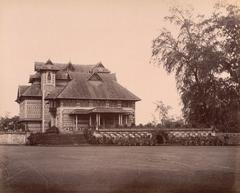Comprehensive Guide to Visiting Puthenthope Beach, Thiruvananthapuram, India
Date: 24/07/2024
Introduction
Puthenthope Beach, located in Kerala’s Thiruvananthapuram district, is a coastal treasure that seamlessly blends serene natural landscapes with a rich historical and cultural heritage. This beach, part of the ancient Travancore Kingdom, has seen various colonial influences, notably from the Portuguese and Dutch, which have left their mark on the local architecture and culture (source). Visitors can experience traditional fishing practices, local festivals, and rituals, all set against the backdrop of lush coconut groves and the Arabian Sea’s azure waters. Whether you’re a history buff, a nature lover, or someone seeking peace and relaxation, Puthenthope Beach offers a unique and fulfilling experience. This guide aims to provide comprehensive information on the beach’s history, cultural significance, visiting hours, ticket information, travel tips, and nearby attractions to help you plan the perfect visit.
Table of Contents
- [Introduction](#introductionintroduction)
- [Historical Background](#historical-backgroundhistorical-background)
- [Colonial Influence](#colonial-influencecolonial-influence)
- [Cultural Significance](#cultural-significancecultural-significance)
- [Environmental Significance](#environmental-significanceenvironmental-significance)
- [Modern-Day Significance](#modern-day-significancemodern-day-significance)
- [Visiting Hours and Ticket Information](#visiting-hours-and-ticket-informationvisiting-hours-and-ticket-information)
- [Travel Tips and Best Times to Visit](#travel-tips-and-best-times-to-visittravel-tips-and-best-times-to-visit)
- [Accessibility and Nearby Attractions](#accessibility-and-nearby-attractionsaccessibility-and-nearby-attractions)
- [Special Events and Guided Tours](#special-events-and-guided-toursspecial-events-and-guided-tours)
- [Photographic Spots](#photographic-spotsphotographic-spots)
- [Conclusion](#conclusionconclusion)
- [FAQ](#faqfaq)
- [References](#referencesreferences)
Historical Background
Puthenthope Beach and its surrounding areas have been inhabited for centuries, with historical records indicating that the region was once part of the ancient Travancore Kingdom. The Travancore Kingdom, known for its progressive administration and cultural advancements, played a significant role in shaping the socio-economic landscape of the region. The name “Puthenthope” is derived from the Malayalam words “Puthen” (new) and “Thope” (grove), reflecting the area’s agrarian past, where coconut groves and other plantations were predominant.
Colonial Influence
During the colonial era, Puthenthope Beach and its vicinity were influenced by European powers, particularly the Portuguese and the Dutch. The Portuguese, who arrived in Kerala in the late 15th century, established trade relations and left a lasting impact on the local culture and architecture. The remnants of Portuguese influence can still be seen in the form of old churches and colonial-style buildings in the nearby areas. The Dutch, who followed the Portuguese, also left their mark on the region. The Dutch East India Company established trade posts and fortifications along the Malabar Coast, including areas near Puthenthope. The blend of Portuguese and Dutch architectural styles is evident in some of the older structures that still stand today.
Cultural Significance
Puthenthope Beach is not just a picturesque destination but also a cultural hub. The beach and its surrounding areas are home to several traditional festivals and rituals that reflect the rich cultural heritage of Kerala. One of the most significant festivals celebrated here is the “Vavu Bali,” a Hindu ritual performed to honor ancestors. The local fishing community also plays a vital role in the cultural fabric of Puthenthope. Traditional fishing practices, such as using “Kettuvalam” (country boats) and “Chakara” (a unique fishing method), are still prevalent. These practices not only provide a livelihood for the local population but also offer a glimpse into the age-old traditions that have been passed down through generations.
Environmental Significance
Puthenthope Beach is part of the larger coastal ecosystem of Kerala, known for its unique biodiversity. The beach is flanked by lush coconut groves and casuarina trees, providing a natural habitat for various species of flora and fauna. The coastal waters are home to diverse marine life, making it an important site for marine biodiversity. The beach also plays a crucial role in coastal protection. The natural vegetation along the shoreline acts as a buffer against coastal erosion and helps in maintaining the ecological balance. Efforts have been made by local authorities and environmental organizations to preserve the natural beauty and ecological significance of Puthenthope Beach.
Modern-Day Significance
In recent years, Puthenthope Beach has gained popularity as a tourist destination, attracting visitors from across the globe. The tranquil ambiance, coupled with the scenic beauty of the beach, makes it an ideal spot for relaxation and rejuvenation. The local government has undertaken several initiatives to promote sustainable tourism in the region, enhancing the visitor experience while ensuring minimal environmental impact.
Visiting Hours and Ticket Information
Puthenthope Beach is open to visitors 24 hours a day, making it convenient for early morning strolls or evening sunset views. There is no entry fee to visit the beach, making it an accessible destination for all.
Travel Tips and Best Times to Visit
The best time to visit Puthenthope Beach is during the winter months (November to February) when the weather is pleasant. Monsoon season (June to September) can also be beautiful but may disrupt beach activities due to heavy rainfall.
Accessibility and Nearby Attractions
Puthenthope Beach is easily accessible by road from Thiruvananthapuram city, which is about 18 kilometers away. Nearby attractions include the St. Ignatius Church and the Anchuthengu Fort, both of which offer a glimpse into the region’s colonial past.
Special Events and Guided Tours
Several festivals and events are celebrated at Puthenthope Beach throughout the year. Guided tours are available for those interested in exploring the historical and cultural aspects of the region.
Photographic Spots
Puthenthope Beach offers stunning photographic opportunities, especially during sunrise and sunset. The picturesque landscape, coupled with the traditional fishing activities, makes it a favorite among photographers.
Conclusion
Puthenthope Beach stands out as a multifaceted destination that offers a unique blend of natural beauty, historical depth, and cultural richness (source). From its serene shores and lush landscapes to its significant historical landmarks and vibrant local traditions, the beach caters to a diverse array of interests. Whether you are looking to relax, explore, or immerse yourself in local culture, Puthenthope Beach has something to offer. The ongoing efforts to promote sustainable tourism and preserve the natural and cultural heritage ensure that this coastal gem will continue to enchant visitors for generations to come. For an enriching and memorable experience, consider visiting during the winter months when the weather is most pleasant, and don’t miss out on the nearby attractions and local festivities that add to the beach’s charm.
FAQ
Q: What are the visiting hours for Puthenthope Beach? A: Puthenthope Beach is open 24 hours a day.
Q: Is there an entry fee for Puthenthope Beach? A: No, there is no entry fee to visit Puthenthope Beach.
Q: Are there guided tours available at Puthenthope Beach? A: Yes, guided tours are available, especially for exploring the historical and cultural aspects of the region.
Q: What is the best time to visit Puthenthope Beach? A: The best time to visit is during the winter months (November to February) when the weather is pleasant.
Q: What are some nearby attractions to Puthenthope Beach? A: Nearby attractions include St. Ignatius Church and Anchuthengu Fort.
References
- Puthenthope Beach - History, Visiting Hours, and Travel Tips for Thiruvananthapuram’s Coastal Gem, 2024, Holidify (source)
- Discover Puthenthope Beach - Visiting Hours, Tickets, and Top Attractions in Thiruvananthapuram, 2024, Holidify (source)
- Ultimate Guide to Visiting Puthenthope Beach, Thiruvananthapuram - Best Times, Tickets, and Tips, 2024, Holidify (source)





